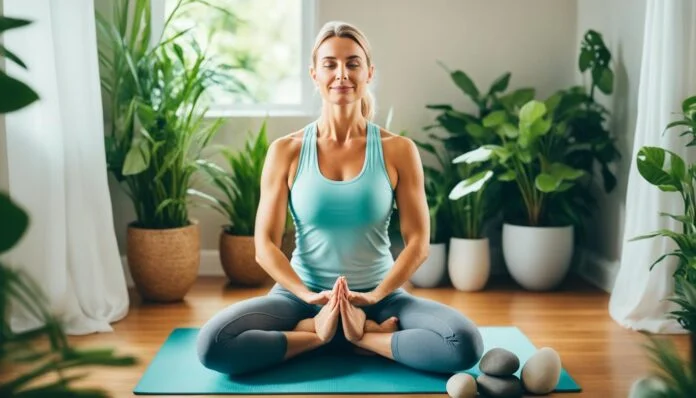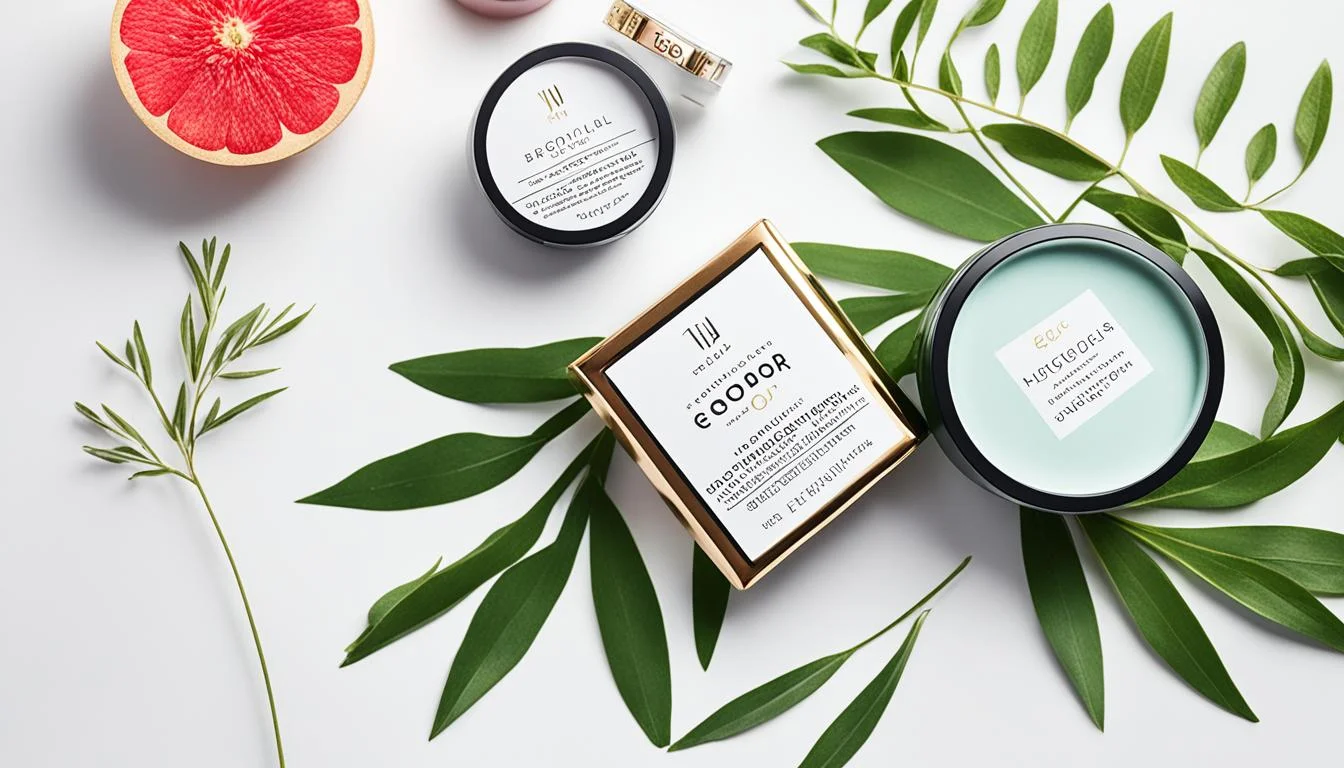
Did you know that just a few minutes of movement during your workday can make a big difference in your wellness? Studies show these short breaks boost productivity and improve mental health. They give us purpose and make us feel better about ourselves. Effective wellness routines are key to better health and happiness.
In today’s busy world, daily habits for self-care and balance are crucial. By exploring wellness routines, we can build healthy habits for our body and mind. Let’s discover how these routines can change our lives for the better.
Key Takeaways
- Incorporating hydration practices first thing in the morning boosts our wellness journey.
- Regular movement breaks are essential for maintaining overall wellness throughout the day.
- Daily meditation, even for a few minutes, can improve our general well-being.
- Social interactions contribute significantly to our emotional health and should be included in our routines.
- A consistent sleep schedule enhances our energy levels and emotional resilience.
- Practicing gratitude can help refocus our thoughts, enriching our daily experiences.
The Importance of Wellness Routines
Starting a wellness routine is key to better health and happiness. It brings structure and predictability to our days. This helps reduce chaos and gives us stability in uncertain times.
Understanding the Role of Routines in Wellbeing
Regular routines are crucial for our mental and physical health. They guide us with activities that boost our wellbeing. These activities include:
- Incorporating physical activity which contributes to physical and mental health, boosting overall wellbeing.
- Adequate hydration, essential for digestion and energy levels, further supporting our health.
- Practicing mindful eating, which enhances our relationship with food and prevents overeating.
- Establishing a consistent sleep schedule, vital for adequate rest and wellness maintenance.
How Routines Foster Stability and Control
Wellness routines help us control our habits and choices. They make us feel safe and stable in our daily lives. Taking short breaks helps prevent burnout and boosts focus and productivity.
Doing hobbies and creative activities also helps us relax and support our emotional health. Setting goals keeps us motivated and focused on staying positive on our wellness path.
Key Components of Wellness Routines
To make wellness routines work, we need to focus on key elements. These elements help us stay healthy and happy. By adding these important parts to our lives, we get a full approach to feeling good.
Sticking to patterns helps us build healthy habits. These habits help our body and mind.
Healthy Habits for Daily Life
It’s key to have healthy habits for our well-being. Adults should aim for 150 minutes of exercise each week. Doing more can be even better for us.
Eating foods good for our brain, like the Mediterranean diet, can boost our mental health. It might even lower the chance of feeling depressed.
- Prioritize a balanced breakfast, including complex carbohydrates, healthy fats, and proteins.
- Commit to daily physical activity, aiming for at least 30 minutes.
- Stay hydrated by drinking a glass of water upon waking up.
- Incorporate brain-healthy foods into meals, such as fruits and vegetables.
Integrating Self-Care Practices
Adding daily self-care helps us handle stress better and be more productive. Just 10 minutes of meditation each morning can lessen anxiety and make us feel better. Getting 7 to 8 hours of sleep each night is also key. It helps us feel refreshed and ready for the day.
| Practice | Benefits | Recommended Frequency |
|---|---|---|
| Physical Activity | Improves mood and self-esteem | 150 minutes/week |
| Healthy Eating | Supports mental health | Daily |
| Meditation | Reduces anxiety | 10 minutes daily |
| Hydration | Enhances physical performance | Daily |
| Adequate Sleep | Boosts immune function | 7-8 hours each night |
Starting Your Day on the Right Foot
Starting your day right can change how you feel all day. By adding good habits to your morning, you set a positive tone. This can make you feel better overall.
Practicing mindfulness, drinking water, and eating a healthy breakfast can help you face the day with confidence.
Morning Mindfulness Exercises
Starting with mindfulness can clear your mind and keep you calm. Simple things like meditation or stretching can help you focus and reduce stress. These activities can make you feel happier and ready for the day.
- Meditation: Just 5 to 10 minutes of meditation can calm your mind and improve focus.
- Journaling: Writing down your thoughts can help organize your mind.
- Breathwork: Deep breathing can lower anxiety and set a calm mood.
The Power of Hydration and Nutrition
Drinking water first thing helps wake up your metabolism and supports your body. A glass of water refreshes you. Then, eating a balanced breakfast is key. Include proteins, healthy fats, and complex carbs for energy.
- Hydration: Drinking enough water in the morning helps fight tiredness.
- Nutritious breakfast: Foods like eggs, avocados, and whole grains give you the nutrients you need.
- Meal Planning: Planning your breakfast the night before makes mornings easier.

| Key Components | Benefits |
|---|---|
| Mindfulness Exercises | Enhance focus, reduce stress, and promote positivity |
| Hydration | Replenishes fluids, boosts metabolism, and reduces fatigue |
| Nutritious Breakfast | Provides energy, stabilizes blood sugar, and sustains focus |
Combining these elements into your morning routine creates a supportive environment for success. A balanced morning routine builds resilience and boosts your overall wellbeing.
Boosting Midday Productivity
To boost our midday productivity, we need to find ways to fight the afternoon slump and manage stress. Studies show that keeping our energy up during the day can greatly improve our work performance.
Combatting the Afternoon Slump
The afternoon slump usually hits between 1-3 p.m., making us less productive. To fight this, we can take active breaks. Short activities like stretching or a quick walk can make us feel more alive and creative. Even a 20-minute nature break can lift our mood and energy.
Keeping regular meal times is key to staying productive. Eating a healthy lunch keeps our energy up and stops burnout. Drinking enough water is also crucial; women need about 9 cups and men about 13 cups a day. Staying hydrated helps prevent feeling tired, which boosts our mood and work performance.
Stress Management Techniques During Work Hours
Dealing with stress at work can be tough. Deep breathing exercises can help in stressful situations. Simple practices like pranic breathing send energy into our bodies, giving us a fresh boost. Taking mindful breaks helps reset our minds, reducing tension and improving focus.
Connecting with colleagues during breaks can make work better. Talking with coworkers improves our mental health and highlights the importance of our interactions. Adding these activities to our daily routine helps us stay productive.
Incorporating Fitness Regimens into Your Routine
Adding fitness to our daily life boosts our health and happiness. It’s key to pick the right mix of exercises and stick to a schedule that fits us. By mixing different activities, we make fitness fun and lasting.
Finding the Right Exercise Mix
For a great fitness plan, mix cardio, strength, flexibility, and balance exercises. This mix helps us stay healthy. The Department of Health and Human Services suggests:
- 150 minutes of moderate cardio or 75 minutes of hard cardio each week.
- 300 minutes of cardio for weight loss or keeping weight off.
- Strength training for major muscles twice a week.
- Core exercises to strengthen your stomach and back.
- Balance exercises to prevent falls.
- Stretching to improve how well you move and your posture.
Creating a Balanced Fitness Schedule
Plan your workouts like you would any other appointment. Short 5-, 10-, or 15-minute activities can fit into a busy day. Aim for a mix that keeps you active and balanced.
| Activity Type | Intensity Level | Duration per Week |
|---|---|---|
| Aerobic Exercise | Moderate | 150 min |
| Aerobic Exercise | Vigorous | 75 min |
| Strength Training | Varied | 2 sessions |
| Core Exercises | Varied | 2-3 sessions |
| Balance Exercises | Low | As needed |
| Flexibility and Stretching | Low to Moderate | 3-4 sessions |
Staying active boosts our mood, cuts down on tiredness, and leads to a healthier life. By making fitness fun and rewarding, we build habits that help us feel good.
Creating a Healthy Work-Life Balance
Getting a good work-life balance takes effort and clear plans. Setting boundaries between work and personal life is key to avoiding burnout and feeling happy at work. By knowing what keeps us mentally healthy, we can live a more rewarding life.
Setting Boundaries for Work and Personal Time
It’s vital to protect our personal time by setting boundaries. In the U.S., over 60% of workers feel their work-life balance is off. This often happens with remote work, making it hard to separate work from home life. Here’s how we can help:
- Set clear work hours to avoid distractions.
- Create tech-free areas, like during meals or at night.
- Try the Pomodoro technique to manage tasks better.
Writing down daily goals can also help. It lowers stress and boosts feelings of achievement. These steps help us understand how to keep our work and personal lives in balance.
Strategies for Social Wellbeing
Improving social wellbeing is key to feeling happy and resilient. Being around others can greatly improve our mental health. Here are ways to build social connections:
- Do activities with friends or family once a month to keep relationships strong.
- Make time for hobbies and interests twice a week to lower stress and increase joy.
- Have positive talks with coworkers during the day to build a supportive work environment.
By focusing on these areas, we can grow our support networks and boost our social wellbeing. This not only makes us happier at home but also improves our work life.

Evening Routines for Relaxation
As the day ends, it’s key to have a good evening routine for better sleep. Adding relaxation techniques helps tell our body it’s time to relax. Doing calming things like yoga, reading, or a warm bath makes falling asleep easier.
Calming Activities Before Bedtime
Doing calming activities gets us ready for sleep and makes us more relaxed. Here are some ideas:
- Read books that calm you down, not excite you. Choose non-fiction or light stories.
- Try yoga to let go of the day’s stress and prepare for sleep.
- Have a light snack like fruit or yogurt to soothe your stomach.
- Write in a journal or make a to-do list to clear your mind.
- Make your bedroom a sleep haven by keeping it cool and quiet.
Practicing Sleep Hygiene to Enhance Rest
Good sleep habits are crucial for deep sleep. Sticking to a regular sleep schedule helps our body know when it’s bedtime. Cutting down on screen time before bed reduces blue light, which helps us feel sleepy.
A calming bedtime routine of 30 to 60 minutes improves sleep quality. Taking a warm bath relaxes you, and writing down thoughts eases stress. This routine sets the stage for better sleep, leading to better health and happiness.
| Activity | Benefits |
|---|---|
| Warm Bath | Trigger relaxation response and prepare the body for sleep. |
| Reading | Promotes healthy sleep; choose calming genres. |
| Yoga | Reduces tension and induces relaxation. |
| Light Snacks | Calms the stomach for better sleep quality. |
| Journaling | Sorts thoughts and aids in quicker sleep onset. |
Assessing Your Mental Health Strategies
Understanding our mental health is key, especially with the big impact of recent events. It’s important to know when we need help or changes. By checking in with ourselves and using support, we can find good mental health strategies.
Recognizing Signs of Stress and Anxiety
About 53% of Americans say the COVID-19 pandemic has hurt their mental health. Signs include feeling irritable, tired, or having trouble focusing. Noticing these feelings helps us deal with our emotions better. Knowing what stresses us out helps us find better ways to cope, making our emotional health a priority.
Effective Tools and Techniques for Support
On our path to better mental wellness, we can try different support methods. Tools like mindfulness, journaling, and being with others help a lot with anxiety. Doing things like art or helping out can make us feel connected and valued.
Working with experts, like psychiatric mental health nurse practitioners, can give us specific ways to cope. They can help figure out what’s going on and suggest ways to feel better. With regular self-care and focusing on our mental health, we can live better and bounce back from tough times.
Conclusion
Effective wellness routines are key to boosting our holistic health and improving our daily lives. They bring order and give us the tools to handle life’s challenges. By slowly adding and tweaking our wellness plans, we can find more balance and energy.
Studies show that routines like regular sleep schedules help both kids and adults stay healthy. Daily habits like drinking enough water, staying active, and taking breaks keep our energy up and help us bounce back from stress.
Let’s stick to these good habits and be open to making changes. Doing so will make us feel better and help us live happier, healthier lives. It will also make those around us happier and healthier too.
FAQ
What are wellness routines and why are they important?
Wellness routines are daily habits that help us stay healthy and happy. They make our lives more predictable, reducing stress and anxiety.
How can we establish a consistent wellness routine?
First, set your wellness goals. Then, pick healthy habits that fit those goals. Finally, make a plan to add these habits to your daily life.
What are some effective mindfulness exercises to incorporate into our morning routine?
Start your day with mindfulness. Try meditation, stretching, or deep breathing. These activities improve focus, reduce stress, and set a positive day ahead.
How can we boost our productivity during the workday?
Take short breaks for stretching or walking to fight the afternoon slump. Deep breathing can also help manage stress at work.
What should a balanced fitness regimen include?
A good fitness plan should have cardio, strength training, and flexibility exercises. Choose activities that fit your goals, preferences, and schedule for fun and lasting results.
How can we maintain a healthy work-life balance?
Keep work and personal life separate by setting boundaries. Schedule time for social activities and build strong relationships to improve your well-being.
What time of day should we focus on relaxation activities?
Relax in the evening with reading or yoga. Good sleep habits and less screen time before bed also help improve sleep quality.
How can we assess and improve our mental health strategies?
Notice when you feel stressed or anxious to understand your mental health needs. Use mindfulness, journaling, and support groups for help and strategies.
What role does nutrition play in our wellness routines?
Good nutrition is key to wellness. It keeps energy up, supports health, and helps with mood. Eating well boosts daily productivity and overall health.






